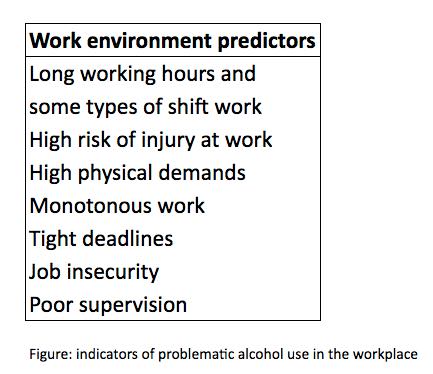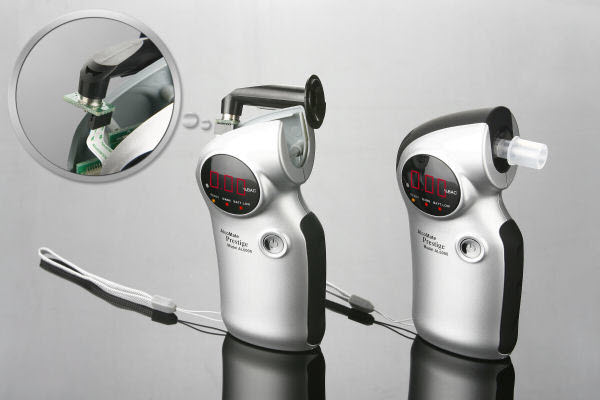Are Accidents Related to Alcohol Common in the Workplace?
The merry season is here once more, but some people find it difficult to curb their drinking at times, and at this time every year there is a spike in accidents related to increased alcohol levels. When this is combined with work-related festive events that include alcoholic beverages, management of businesses and corporations have to figure out ways to deal with this issue.
Norwich Union Healthcare commissioned a report in 2007 that revealed the following issues with alcohol in the workplace:
- 30% of employees have shown up to work in a hungover state
- 15% admitted to being drunk while at work
- Hangovers or intoxication resulted in work-related problems, including problems concentrating, a drop in productivity, errors and tiredness
- 25% admit to just turning up for work and doing the minimum after alcohol
- 42% admitted that alcohol had made them tired, to the point of sleepiness, at work
- 10% were hungover at work at least once per month and 5% weekly
- 77% of employers interviewed said alcohol was a serious threat to the well-being of employees and a major reason for absence due to sickness
Which Sectors Have the Highest Risks for Problem Drinking?
For businesses in the UK, alcohol is a major productivity and safety concern and not only during festive times of the year. So is there a way to minimise the impact?
In 2016 Dame Carol Black conducted and published an independent review, commissioned by the government, on drug and alcohol addiction and the impact on employment. They discovered that the increased consumption of alcohol could be attributed to the workplace itself.
Risks highlighted in the report that pertained to features of employment include tight timelines, long shifts, job insecurity and monotonous work.
The report also identified a concern regarding providing support to professionals who are dealing with alcohol problems.

An article in a newspaper in 2011 highlighted the necessity for healthcare experts to take urgent action to deal with the “significant challenge” of the increase alcoholism and substance abuse levels among professionals like lawyers, doctors and dentists.
There is a persistent problem in the medical sector as outlined in a Pulse magazine survey in 2017 that discovered that 11% of GPs used alcohol to let them “deal with work pressures”. (Also, a further 6% of doctors admitted to taking illegal drugs to help relieve job pressure)
Similarly, government data on adult drinking habits suggests that high-earners (those with a salary over £40,000 per year) are often more likely to be drinkers on a frequent basis that those on a lower wage. They are also more inclined to “binge” on the day they drink most.
According to the Health & Safety Executive (HSE), absence from work due to alcohol, or alcohol-related sickness, is estimated to result in 3-5% of all work absences from work. In real terms this means that the UK loses 8 to 14 million working days per year due to alcohol.
The damaging effects of alcohol consumption include lower work performance, broken customer relations and resentment among employees who may feel that they are having carry their colleagues whose work-effectiveness is reduced by alcohol.
Because alcohol abuse can result in a drop in productivity, workplace accidents and time off work, the HSE suggest that employer’s implement a holistic alcohol policy working closely with their staff. The outcome would include the expectation of the organisation on the employees to minimise their drinking; how to pinpoint alcohol problems and provide support; and when the alcohol consumption of an employee is a disciplinary issue instead of a health issue.
Workplace Alcohol Policies
Having a clear workplace alcohol policy is an important step for any business looking to address alcohol issues among staff. A good policy should cover:
- Expectations around alcohol consumption — Make clear the rules, such as no drinking during work hours or arriving at work under the influence. Staff should know what behaviour is not acceptable.
- Support for staff with alcohol problems — The policy should emphasise support and outline the assistance available for those who need help with alcohol misuse. This may include counselling, referral to treatment programmes, flexible work arrangements during recovery, etc.
- Disciplinary procedures — While support is crucial, the policy must also spell out disciplinary actions for those who violate rules around alcohol use. Procedures should be transparent and applied consistently.
- Roles and responsibilities — Explain the roles managers, HR, occupational health and employees play in implementing the alcohol policy. Make sure everyone understands expectations.
- Communication plan -Describe how the policy will be communicated to all staff through training sessions, the employee handbook, posters in the workplace, etc. Awareness is critical.
Benefits of a Workplace Alcohol Policy
Implementing a clear alcohol policy has many advantages, including:
- Promotes health and safety by reducing alcohol-related risks
- Supports staff in getting help for alcohol problems
- Creates a productive work environment with clear standards
- Protects employer from liability issues related to alcohol misuse
- Shows customers/clients that alcohol misuse is taken seriously
To be effective, employers must enforce the alcohol policy consistently. Annual training can help ensure it remains top of mind for staff and management.
Creating a Culture of Alcohol Awareness
Let’s face it – changing workplace habits isn’t a walk in the park. But with the right approach, you can foster a culture where responsible drinking isn’t just a policy, it’s second nature.
Start by getting everyone on board. From the CEO to the newest intern, make sure they’re all singing from the same hymn sheet. Host engaging workshops that don’t just lecture, but invite open dialogue. You might be surprised at the insights your team can offer!
Why not shake things up with a “Mocktail Monday” or a “Dry January” challenge? These fun initiatives can spark conversations about alcohol-free alternatives and help employees rethink their relationship with booze.
Remember, Rome wasn’t built in a day. Changing cultural norms takes time, patience, and a dash of creativity. But by consistently reinforcing your message and leading by example, you’ll be well on your way to creating a healthier, happier, and more productive workplace. After all, isn’t that worth raising a glass to?
Signs of Alcohol Abuse at Work
Managers have an important role in identifying alcohol issues early. Warning signs of alcohol abuse at work can include:
- Repeated lateness, absenteeism or sick days, especially Mondays or Fridays
- Decline in work performance or increase in mistakes
- Difficulty concentrating, remembering instructions
- Slurred speech, tremors, lack of coordination
- Aggressive behaviour, mood swings, irritability
- Smelling of alcohol, hiding drinking (water bottles, mouthwash)
- Isolation from colleagues, relationship issues
Addressing problems compassionately but directly is key to getting staff the help they need.
Supporting Employees with Alcohol Addiction
Employers should view alcohol addiction as a treatable medical condition, not a personal failing. With supportive company policies and access to professional treatment, many employees fully recover.
Components of a supportive approach include:
- Offering leave for treatment and recovery
- Arranging return to work accommodations like reduced hours
- Referral to counselling, addiction services and support groups
- Access to addiction education and awareness training
- Open communication regarding lapses and relapses
- Ongoing monitoring and encouragement
With the right mix of high expectations and compassionate support, companies can create a workplace where alcohol misuse is minimised and those dealing with addiction are empowered to seek help.
Workplace Alcohol Testing
In the rail and maritime industries, for instance, testing for alcohol is mandatory and required as per regulatory requirements. For most other industries, alcohol testing isn’t mandatory. A survey commissioned by BRAKE discovered that less than half of employers (44%) would fire an employee driver for being over the legal limit for alcohol. It showed that:
- Over half of employers never test for drugs (57%) or alcohol (55%)
- Over sixty percent (62%) discipline employees who had illegal drugs or alcohol in their system during working hours; however, only 30% would fire an employee for this reason
- Only 47% provide employee education on drug-driving risks, and just a bit more (50%) provide education on drink-driving risks
- A zero-tolerance policy is suggested by the road safety charity for employees who drink-drive during working hours.
A previous report published by BRAKE in 2012 suggested that those who drove for a living were more likely to drive in the morning after boozing the night before. The were also more likely to use illegal drugs and then drive, when compared to those drivers who who did not drive for work purposes.
What is the Responsibility of the Employer in Terms of Alcohol?
These days, employees have to be aware of the alcohol-dependent signs of their employees. Even though an employee could be fired for gross misconduct when drunk at work, employment protection law is more conscious of the root issue of alcohol dependency. Employers are forced to address that dependency as a kind of sickness, and the employee has to be given the chance to cure the problem.
Of even greater concern, a Chartered Institute of Personal Development survey discovered that just 33% of employers provided any formal training to their managers regarding drug and alcohol policy and management issues. Forty-three (43%) of workplaces have no alcohol policy in place, while only 27% had procedures in place for managing staff to use for alcohol related issues.
A number of businesses now use workplace alcohol policies to make sure that staff is sober while at work and to recognise and assist workers with that need help. They are usually seen in big companies and those that are safety-sensitive, like transportation. (The Alcohol Focus Scotland website has a handy, free workplace alcohol and drugs policy template. This can be a good starting point if your business does not have a policy in place.)
Businesses have to be proactive in managing the alcohol problem, and this season is the best time to get started without raising red flags that it is a big problem inside the organisations.
In recent years, we have consulted with some popular big companies and local authorities, offering simple, disposable breath testers for business promotions and events. Offering breathalyser kits to your employees is a great icebreaker and trigger for talking about the view of the employer regarding alcohol at work.
There are unique ways to give tests to employees like a party bag at the conclusion of an employee party. This is an inexpensive approach that is effective for business and is applicable anywhere that alcohol is served to employees or it could be included in corporate marketing and hospitality. A number of businesses have also made these kits available to employees for self-testing in “the morning after” situations.
Disposable, saliva alcohol tests are another low-cost control that can be given to staff or kept in accessible locations.
Another option is to invest in a company breathalyser that can be stored in a handy location. The two models we offer — AL6000 and AL7000 — are both easy to use, simple to maintain and perfect for company alcohol testing.
For many years now, Zoom Testing has provided drug and alcohol testing kits to companies. Do you want help or to learn more? If so, please contact us.
Photo Credit: “Work” by Anthony Cunningham for Zoom Testing
Zoom Testing is a leading UK drug testing company and a supplier of Drug Test Kits.






